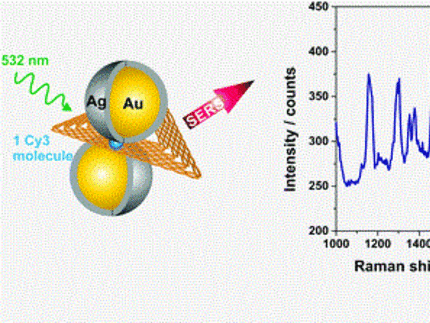DNA nanotechnology for optical spectroscopy
Overview
DNA origami is a fascinating technique that allows for the precise arrangement of nanoparticles, fluorescent dyes, specific DNA structures (such as aptamers) and proteins into well-defined arrays. Consequently, DNA origami nanostructures have been used to fabricate a variety of plasmonic nanostructures by the controlled arrangement of metallic nanoparticles. Surface-enhanced Raman scattering (SERS) is one of the most promising analytical techniques for bioanalytics, capable of single-molecule detection and true multiplexing. However, the fabrication of efficient SERS substrates remains one of the most difficult challenges in SERS, since SERS relies on the formation of hot spots within Au or Ag nanoparticle aggregates and the placement of analyte molecules specifically into the hot spots.
We use DNA origami nanostructures to fabricate intense Raman scattering hot spots between nanoparticles and to place target molecules precisely into these hot spots to enable highly sensitive detection of analyte molecules down to the single-molecule level.
Furthermore, we use DNA origami scaffolds to arrange fluorescent dyes to enable novel schemes for fluorescent based sensing. We also explore their application in fiber optical sensing.
Selected publications
Spatial Separation of Plasmonic Hot Electron Generation and a Hydrodehalogenation Reaction Center Using a DNA Wire; S. Kogikoski Junior, A. Dutta, I. Bald, ChemRxiv. Preprint. doi.org/10.26434/chemrxiv.14114306.v2
A versatile DNA origami based plasmonic nanoantenna for label-free single-molecule SERS; K. Tapio, A. Mostafa, Y. Kanehira, A. Suma, A. Dutta and I. Bald, ACS Nano 2021, accepted. DOI: 10.1021/acsnano.1c00188.
Raman Enhancement of Nanoparticle Dimers Self-Assembled Using DNA Origami Nanotriangles; S. Kogikoski, K. Tapio, R. E. von Zander, P. Saalfrank, I. Bald Molecules , 26, 1684 (2021)
Amorphous Carbon Generation as a Photocatalytic Reaction on DNA-Assembled Gold and Silver Nanostructures; C. Heck, Y. Kanehira, J. Kneipp, I. Bald, Molecules 2019, 24, 2324.
A new reporter design based on DNA origami nanostructures for quantification of short oligonucleotides using microbeads, Y. Choi, C. Schmidt, P. Tinnefeld, I. Bald and S. Rödiger, Sci. Rep. 2019, 9, 4769.
DNA Origami Based FRET Nanoarrays and their Application as Ratiometric Sensors, Y. Choi, L. Kotthoff, L. Olejko, U. Resch-Genger, I. Bald, ACS Appl. Mater. Interfaces2018, 10, 23295.
Single proteins placed within the SERS hot spots of self-assembled silver nanolenses, C. Heck, Y. Kanehira, J, Kneipp, I. Bald, Angew. Chem. Int. Ed.2018, 57, 7444.
FRET efficiency and antenna effect in multi-color DNA origami-based light harvesting systems; L. Olejko, I. Bald, RSC Adv. 2017, 7, 23924.
Gold Nanolenses Self-Assembled by DNA Origami; C. Heck, J. Prinz, A. Dathe, V. Merk, O. Stranik, W. Fritzsche, J. Kneipp, I. Bald, ACS Photonics 2017, 4, 1123.
Hybrid Structures for Surface-Enhanced Raman Scattering: DNA origami / Gold Nanoparticle Dimer / Graphene; J. Prinz, A. Matković, J. Pešić, R. Gajić, I. Bald, Small 2016, 12, 5458. Cover: DOI: 10.1002/smll.201670199.
An ion-controlled four-color fluorescent telomeric switch on DNA origami structures; L. Olejko, P. J. Cywiński, I. Bald, Nanoscale 2016, 8, 10339.
DNA origami based Au–Ag-core–shell nanoparticle dimers with single-molecule SERS sensitivity; J. Prinz, C. Heck, L. Ellerik, V. Merk, I. Bald, Nanoscale 2016, 8, 5612.
Ion-Selective Formation of a Guanine Quadruplex on DNA Origami
Structures; L. Olejko, P. Cywinski, I. Bald, Angew. Chem. Int. Ed. 2015, 54, 673.
DNA Origami Substrates for Highly Sensitive Surface-Enhanced Raman Scattering; J. Prinz, B. Schreiber, L. Olejko, J. Oertel, J. Rackwitz, A. Keller, I. Bald, J. Phys. Chem. Lett.2013, 4, 4140-4145. Siehe auch die Pressemitteilung und englisches Medienecho.
PhD theses completed on this topic
Dr. Julia Prinz: DNA origami substrates as a versatile tool for surface-enhanced Raman scattering (SERS)
Dr. Christian Heck: Gold and Silver Nanolenses Self-Assembled by DNA Origami
Dr. Lydia Olejko: Förster resonance energy transfer (FRET)-based nanophotonics using DNA origami structures
Dr. Youngeun Choi: DNA Origami Structures as Versatile Platforms for Nanophotonics
Dr. Till Meiling: Development of a reliable and environmentally friendly synthesis for fluorescence carbon nanodots

